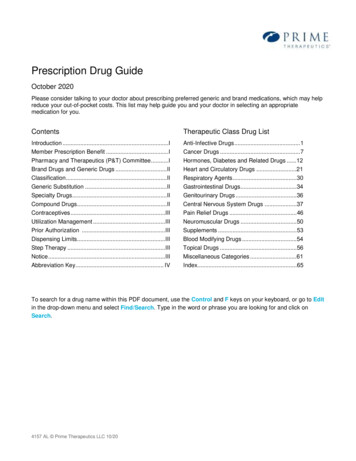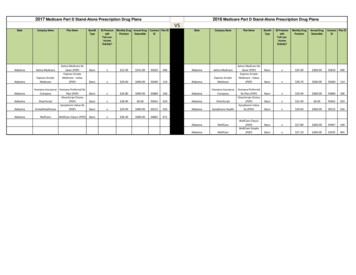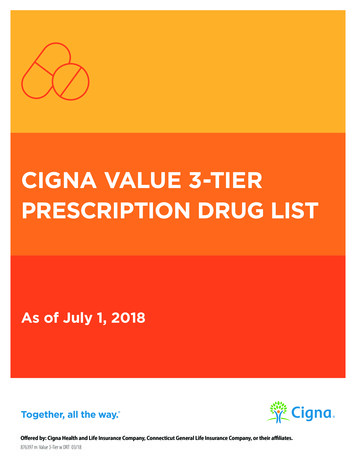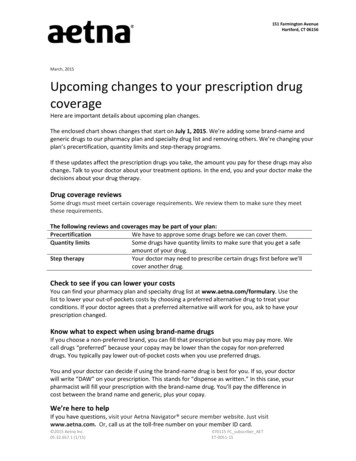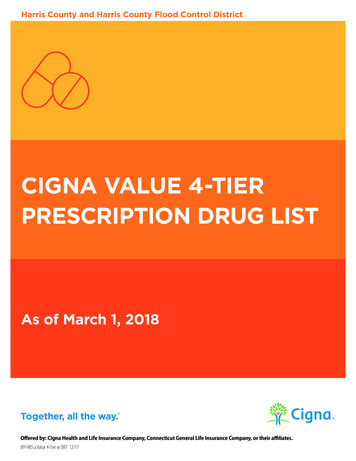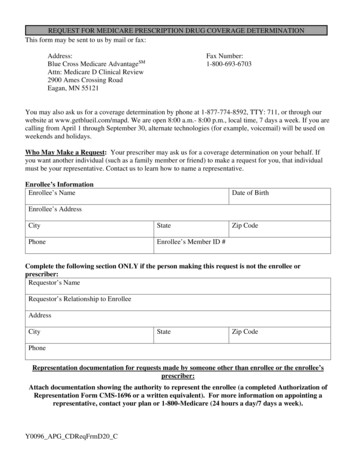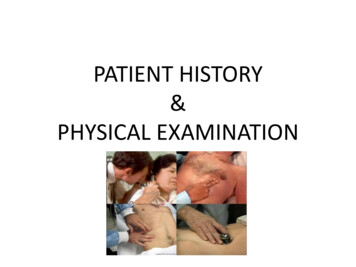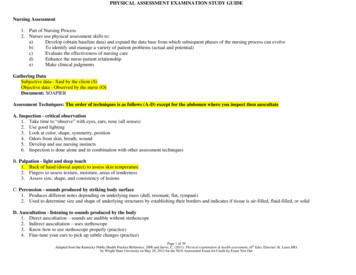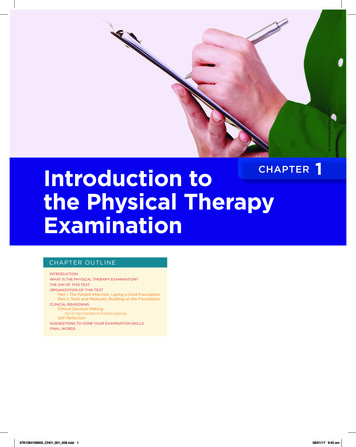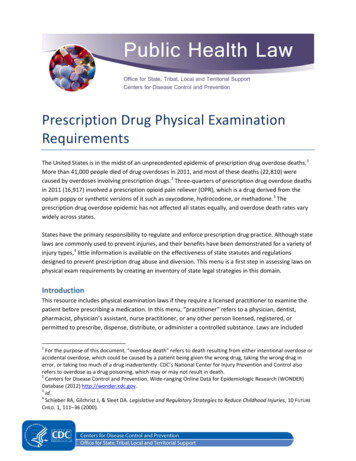
Transcription
Prescription Drug Physical ExaminationRequirementsThe United States is in the midst of an unprecedented epidemic of prescription drug overdose deaths. 1More than 41,000 people died of drug overdoses in 2011, and most of these deaths (22,810) werecaused by overdoses involving prescription drugs. 2 Three-quarters of prescription drug overdose deathsin 2011 (16,917) involved a prescription opioid pain reliever (OPR), which is a drug derived from theopium poppy or synthetic versions of it such as oxycodone, hydrocodone, or methadone. 3 Theprescription drug overdose epidemic has not affected all states equally, and overdose death rates varywidely across states.States have the primary responsibility to regulate and enforce prescription drug practice. Although statelaws are commonly used to prevent injuries, and their benefits have been demonstrated for a variety ofinjury types, 4 little information is available on the effectiveness of state statutes and regulationsdesigned to prevent prescription drug abuse and diversion. This menu is a first step in assessing laws onphysical exam requirements by creating an inventory of state legal strategies in this domain.IntroductionThis resource includes physical examination laws if they require a licensed practitioner to examine thepatient before prescribing a medication. In this menu, “practitioner” refers to a physician, dentist,pharmacist, physician’s assistant, nurse practitioner, or any other person licensed, registered, orpermitted to prescribe, dispense, distribute, or administer a controlled substance. Laws are included1For the purpose of this document, “overdose death” refers to death resulting from either intentional overdose oraccidental overdose, which could be caused by a patient being given the wrong drug, taking the wrong drug inerror, or taking too much of a drug inadvertently. CDC’s National Center for Injury Prevention and Control alsorefers to overdose as a drug poisoning, which may or may not result in death.2Centers for Disease Control and Prevention, Wide-ranging Online Data for Epidemiologic Research (WONDER)Database (2012) http://wonder.cdc.gov.3Id.4Schieber RA, Gilchrist J, & Sleet DA. Legislative and Regulatory Strategies to Reduce Childhood Injuries, 10 FUTURECHILD. 1, 111–36 (2000).
only if they expressly require an examination or evaluation. Laws requiring a practitioner-patientrelationship or use of a valid prescription are included only if the definition of practitioner-patientrelationship or valid prescription expressly requires a physician examination. 5 Forty-one states 6 and theDistrict of Columbia have one or more laws that require a prescriber or dispenser to ensure thatprescriptions for medications are based on an examination of the patient. 7 States with these laws mayrequire a physical examination as part of prescribing regulations, or may prohibit pharmacists andphysicians from dispensing certain types of drugs if there is doubt the drugs were prescribed following aphysical exam. Some states limit the applicability of the laws to certain drug types, apply laws only incertain circumstances, or contain exceptions to examination requirements. 8 Most states 9 and theDistrict of Columbia have multiple physical examination laws and thus fall under multiple categories.Type of Examination RequiredMost examination laws 10 require a ”physical examination” as the basis for prescribing and dispensing acontrolled substance.5Some states, such as Missouri, have come to define the patient-practitioner relationship to include a physicalexamination through judicial interpretation. See State v. Kane, 586 S.W.2d 812 (App. E.D. 1979) (defining “patientpractitioner” as used in MO. ANN. STAT. § 195.204 to mean “first making some attempt to determine physicalcondition or health needs of person for whom he writes the prescription.” Id. Those statutes are not included inthis report.6Alabama, Alaska, Arizona, Arkansas, California, Connecticut, Delaware, Florida, Georgia, Hawaii, Idaho, Indiana,Iowa, Kentucky, Louisiana, Maine, Maryland, Massachusetts, Minnesota, Mississippi, Missouri, Montana,Nebraska, Nevada, New Hampshire, New Jersey, New Mexico, North Carolina, North Dakota, Ohio, Oklahoma,Oregon, Pennsylvania, Rhode Island, South Carolina, Tennessee, Texas, Utah, Vermont, Virginia, and Washington.7The nine states (Colorado, Illinois, Kansas, Michigan, New York, South Dakota, West Virginia, Wisconsin, andWyoming) that do not have physical examination requirements according to this assessment likely have a physicalexamination requirement that may be incorporated into state law through a general provision requiring adherenceto medical professional and ethical standards. The research on which this menu is based was limited to expressprovisions in statute or regulation.8In this menu, the first effective dates of the specific provisions referenced are cited as “[legal citation] (eff.[year]).” Where dates were either not provided within the laws or were unclear due to multiple revisions, this factis cited as “[legal citation] (eff. date unclear, [estimated year]).”9Thirty-seven states: Alabama, Alaska, Arizona, Arkansas, California, Connecticut, Delaware, Florida, Georgia,Hawaii, Idaho, Indiana, Iowa, Kentucky, Louisiana, Maine, Maryland, Minnesota, Mississippi, Missouri, Nebraska,Nevada, New Hampshire, New Jersey, New Mexico, North Carolina, North Dakota, Ohio, Oklahoma, Oregon,Pennsylvania, South Carolina, Tennessee, Texas, Vermont, Virginia, and Washington.10Thirty-four states and the District of Columbia. See, e.g., ALA. ADMIN. CODE r. 540-X-9-.11 (eff. 2000); ALASKA ADMIN.CODE tit. 12, § 40.967 (eff. 2000); ARIZ. REV. STAT. ANN. §§ 32-1401(27)(ss) (eff. 2000), -1501(31)(ww) (eff. 2003),1854(48) (eff. 2000); 060.00.1 ARK. CODE R. § 2 (eff. date unclear); CONN. GEN. STAT. ANN. § 20-613a (eff. 2005); D.C.MUN. REGS. tit. 17, § 4616 (eff. 2012); DEL. CODE ANN. tit. 16, § 4744(c)(1) (eff. 2008); FLA. STAT. § 458.3265 (eff.2011); GA. COMP. R. & REGS. 360-3-.02 (eff. date unclear); HAW. REV. STAT. ANN. § 329-1 (eff. 2008); 844 IND. ADMIN.CODE 5-4-1 (eff. 2003); IOWA ADMIN. CODE r.653-13.2(148,272C) (eff. date unclear); 201 KY. ADMIN. REGS. 8:540 (eff.2012); LA. ADMIN. CODE tit. 46, pt. XLV, § 6921 (eff. 1997); 02-313 ME. CODE R.Ch. 21, § III (eff. 2010); MINN. R.6500.0600 (eff. 1988); 30-17-2635 MISS. CODE R. §7.1 (eff. 2012); MO. REV. STAT. § 334.108 (eff. 2011); NEB. ADMIN.CODE § 172, Ch. 90, § 008 (eff. date unclear); NEV. ADMIN. CODE § 639.945 (eff. date unclear); N.H. REV. STAT. ANN.§318-B:1 (eff. 2011); N.J. ADMIN. CODE § 13:35-7.6(a) (eff. 2003); N.M. CODE R. § 16.10.8 (eff. 2003); 21 N.C. ADMIN.CODE § 46.1801(b) (eff. 2003); N.D. CENT. CODE § 19-02.1-15.1 (eff. 2009); OHIO ADMIN. CODE 4731-11-03 (eff. date2
Indiana“[A] physician shall not prescribe, dispense, or otherwise provide, or cause to be provided, anycontrolled substance to a person who the physician has never personally physically examinedand diagnosed.” 11South CarolinaPrior to prescribing a drug to an individual, a practitioner must “personally perform anddocument an appropriate history and physical examination . . . .” 12Sixteen states 13 and the District of Columbia 14 have laws that require an examination or evaluation thatis deemed “appropriate” or some approximation of “sufficient,” instead of or in addition to the physicalexamination laws. CaliforniaRequires an “appropriate prior examination.” 15 MinnesotaRequires an “in-person examination” that is “adequate to establish a diagnosis and identifyunderlying conditions and contraindications to treatment.” 16 New JerseyWhen a practitioner prescribes a controlled substance, he or she must perform a physicalexamination “including an assessment of physical and psychological function, underlying orcoexisting diseases or conditions, any history of substance abuse and the nature, frequency andseverity of any pain.” 17In some states dispensers are allowed to dispense prescriptions only if the prescription is prescribed bya practitioner who previously performed an adequate examination.unclear); OKLA. ADMIN. CODE § 435:10-7-11 (eff. 2005); 49 PA. CODE § 16.92(b)(1) (eff. 1986); R.I. GEN. LAWS § 21-283.24 (eff. 1974); S.C. CODE ANN. §§ 40-47-113 (eff. 1976); TENN. COMP. R. & REGS. 0880-02-.14(6)(e)(3)(i) (eff. 2001);22 TEX. ADMIN. CODE § 170.3(a)(1), (7) (eff. 2007); UTAH ADMIN. CODE r. 156-37 (eff. date unclear); 18 VA. ADMIN.CODE § 85-20-25 (eff. date unclear); WASH. ADMIN. CODE §246-817-915 (eff. 2011).11844 IND. ADMIN. CODE 5-4-1 (eff. 2003).12S.C. CODE ANN. §§ 40-47-113 (eff. 1976).13See, e.g., CAL. BUS. & PROF. CODE § 2242 (eff. 2000); CONN. AGENCIES REGS. § 21a-326-1 (eff. 1984); IDAHO CODE. ANN.§ 54-1733; IOWA ADMIN. CODE r.650-16.2(153) (eff. date unclear); LA. REV. STAT. ANN. § 40:1238.4 (eff. 2007); MD.CODE REGS. 10.32.05.05 (eff. 2009); 234 MASS. CODE REGS. 9.05 (eff. date unclear); MINN. STAT. § 151.37 (eff. dateunclear); 30-17-2635 MISS. CODE R. § 7.1 (eff. 2012); MO. CODE REGS. ANN. tit. 19§ 30-1.068 (eff. 2000); NEB. ADMIN.CODE § 172, Ch. 56, § 007 (eff. date unclear); NEV. ADMIN. CODE § 635.390 (eff. date unclear); N.J. ADMIN. CODE§ 13:35-7.6 (eff. date unclear); N.M. CODE R. §16.5.57 (eff. date 2013); 22 TEX. ADMIN. CODE §§ 291.29 (eff. 2001);VT. STAT. ANN. tit. 18, § 9361 (eff. 2012).14D.C. MUN. REGS. tIt. 22-B, § 1300.7 (eff. 1986).15CAL. BUS. & PROF. CODE § 2242 (eff. 2000).16MINN. STAT. ANN. §§ 151.37 Subd. 2(d), (e) (eff. date unclear).17N.J. ADMIN. CODE § 13:35-7.6 (eff. date unclear).3
Missouri“[p]rescriptions processed by any . . . pharmacy must be provided by a practitioner . . . who hasperformed a sufficient physical examination and clinical assessment of the patient.” 18A few states simply require an examination before prescribing or dispensing controlled substanceswithout giving specific standards for that examination. 19 Montana“[p]rescribing, dispensing or furnishing any prescription drug without a prior examination and amedical indication therefor,” is unprofessional conduct. 20Applicability of Examination RequirementRegardless of whether a state’s physical examination law applies to prescribers or dispensers, andwhether it requires a physical examination or more general examination or evaluation, the law mightapply only to prescriptions for certain types of drugs or in specific circumstances.Thirty-six states 21 and the District of Columbia 22 have physical examination laws that apply toprescriptions of all drug types or any prescription (includes controlled substances).18MO. CODE REGS. ANN. tit. 20, § 2220-2.020(11) (emphasis added) (eff. 2005).Ten states. See, e.g., CAL. BUS. & PROF. CODE § 805.01 (eff. 2010); IDAHO ADMIN. CODE r. 23.01.01.315 (eff. 1999);IOWA ADMIN. CODE r. 650-16.3(153) (eff. date unclear); 201 KY. ADMIN. REGS. 20:057 (eff. 2012); MONT. ADMIN.R.24.213.2301 (eff. 1998); NEB. ADMIN. CODE § 172, Ch. 120, § 010 (eff. date unclear); NEV. ADMIN. CODE §. 639.235 (eff.date unclear); N.J. ADMIN. CODE § 13:35-7.4 (eff. 2003); OR. REV. STAT. §677.190 (eff. date unclear); S.C. CODE ANN.§ 40-47-965 (eff, date unclear).20MONT. ADMIN .R. 24.213.2301(34) (eff. date unclear, prior to 1998).21See, e.g., ALA. ADMIN. CODE r. 540-X-9-.11 (eff. 2000); ALA. ADMIN. CODE r. 680-X-2-.33 (eff. 2006); ALASKA ADMIN.CODE tit. 12, § 40.967 (eff. date unclear); ARIZ. REV. STAT. ANN. §§ 32-1401(27)(ss), 32-1501(31)(ww), 32-1854(48)(eff. 2000); ARIZ. ADMIN. CODE § R4-23-110 (eff. 2000); ARK. CODE ANN. 17-92-1004(c) (eff. 2007); 070.00.7 ARK. CODER. § 07-00-0009 (eff. 2007); CAL. BUS. & PROF. CODE § 805.01 (eff. 2010); CONN. GEN. STAT. ANN. § 20-613a (eff. 2005);CONN. AGENCIES REGS. § 21a-326-1(c) (eff. 1984); DEL. CODE ANN. tit. 16, § 4744(c)(1) (eff. 2008); FLA. STAT. ANN.§ 465.023(1)(h) (eff. 2009); GA. CODE ANN. § 43-34-25 (eff date. unclear); HAW. REV. STAT. § 329-41 (eff. 2008); IDAHOCODE ANN. § 54-1733(1) (eff. 2006); 844 IND. ADMIN. CODE 5-4-1 (eff. 2003); IOWA CODE ANN. §§ 155A.27, 155A.13B(eff. 2009); KY. REV. STAT. ANN. § 218A.140(3) (eff. 2007); LA. ADMIN CODE. tit. 46, PT. XLVII, § 4513 (eff. date unclear);MD. CODE REGS.10.32.05.05 (eff. 2009); 234 MASS. CODE REGS. 9.05 (eff. date unclear); MINN. STAT. ANN. § 151.34 (eff.date unclear); 30-17-2635 MISS. CODE R. § 7.1 (eff. 2012); MO. CODE REGS. ANN. tit. 20, §§ 2220-2.020(9)(K), (11) (eff.2005); NEB. ADMIN. CODE § 172, Ch. 56, § 007 (eff. date unclear); NEV. ADMIN. CODE § 639.945 (eff. 2001); N.H. REV.STAT. ANN. §§ 318-B:1(XXVI-a) (eff. 2011), -B:2(V)(e), -B:2(XII-b), -B:2(XII-c), -B:2(XII-e)(eff.2013), 329:1-c (eff. 2009),329:17(VI)(l) (eff. 2009); N.J. ADMIN. CODE § 13:35-7.6(a) (eff. 2003); N.M. CODE R. § 16.10.8.8(L) (eff. 2001); 21 N.C.ADMIN. CODE 46.1806 (eff. 2003); N.D. CENT. CODE § 19-03.1-22.4 (eff. 2009); OHIO ADMIN. CODE 4730-2-07(B) (eff.2007); OHIO ADMIN. CODE 4731-11-09(A) (eff. 1999); OKLA. ADMIN. CODE § 535:15-3-13(d) (eff. 2005); OR. REV. STAT.§ 677.190 (eff. date unclear); 49 PA. CODE § 16.92(b)(1) (eff. 1986); S.C. CODE ANN. § 40-47-113 (eff. 2006); S.C. CODEANN. § 44-117-340 (eff. 2007); TENN. COMP. R. & REGS. 1050-02-.13 (eff. 2001); 22 TEX. ADMIN. CODE § 190.8(1)(L) (eff.date unclear, 2003 or later); VT. STAT. ANN. tit. 18, § 9361 (eff. 2012); VA. CODE ANN. § 54.1-3303 (eff. 2000).22D.C. MUN. REGS. tit. 22-B, § 1300.7 (eff. 1986).194
Mississippi“[P]roper prescribing and legitimate medical practice require . . . an appropriate physical . . .before prescribing any medication for the first time.” 23ArkansasAn in-person physical examination “prior to the issuance of any prescription is required in orderto establish a valid prior patient-practitioner relationship for purposes.” 24A smaller number of states 25 and the District of Columbia 26 have laws that apply when using drugs orcontrolled substances for pain management treatment. OklahomaRequires a physical examination where a physician prescribes medication to “treat a patient'sintractable pain.” 27Te
without giving specific standards for that examination. 19 Montana “[p]rescribing, dispensing or furnishing any prescription drug without a prior examination and a medical indication therefor,” is unprofessional conduct. 20 . Applicability of Examination Requirement
